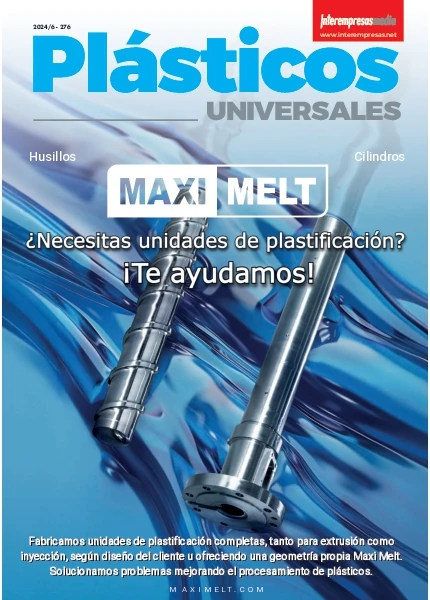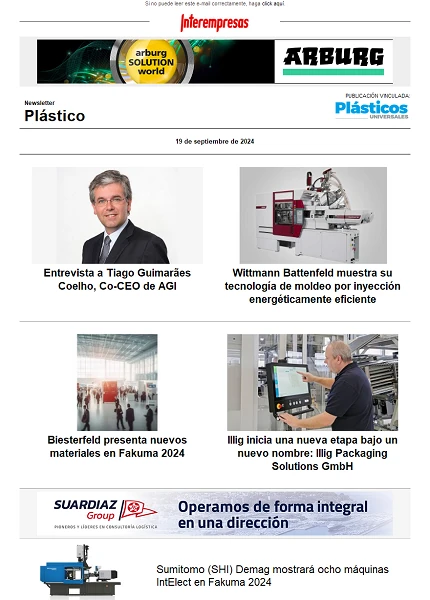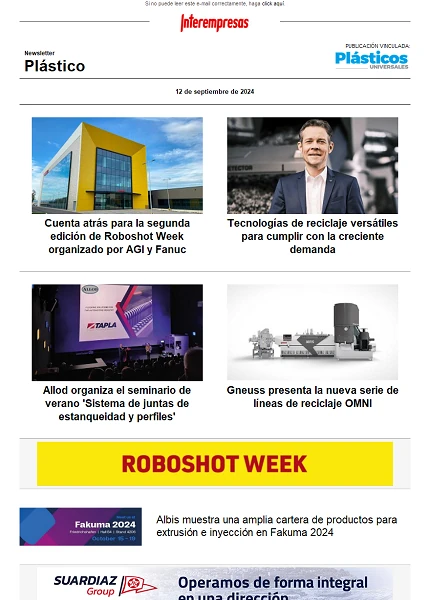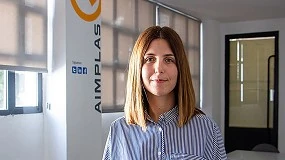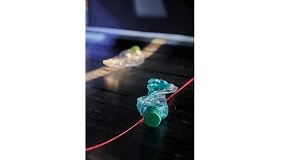Through conformales channels temperature control
December 14, 2010
Since 1995, the production of inserts has been one of the main applications of the technology of EOS m. Through the continuous improvement of technology and the introduction some years on the market of the material steel Maraging Steel MS1 DIN 1.2709 (which meets the high requirements in the production of molds for production)It has been input to other applications such as mold production series and even injection of metal melted under high pressure (die casting). In addition to the advantage of the reduction in the time of manufacture, with this new material was created an additional advantage given by the unique freedom in design of geometries: the advanced mold (Advanced Tooling)
One of the most important applications of "advanced tooling" is the integration of channel of cooling with three-dimensional shapes or conformales. This helps both the improvement of the quality of the final piece injected and the decrease of costs to reduce injection cycle. Currently the inserts produced by the Eosint M are used to produce millions of injected parts, or several thousand parts by injection of metal melted under high pressure (die casting).
Recently, the introduction of the latest model of machine from EOS, the Eosint M280 with 400W of power laser allows to virtually double the productivity of the system in the manufacture of advanced moulds and dies. The gain in height of up to 325 mm system allows the manufacturing of channels conformales on pre-formas already machined, reducing time of manufacture.
The DMLS technology enables any design in the cooling channels
Cooling through channels conformales with DMLS technology allows these advantages and improvements:
In relation to the geometry of the Insert
• Options of conformal to the cooling channels route are virtually infinite. This allows the creation of a suitable cooling channel with a distance to the perfectly defined cavity. A conventional drilling for refrigeration system can not reach the same route.
• Cross sections of cooling channels can take virtually any form (for example, oval instead of circular) (figura1). The degree of turbulence in the cooling circuit of the mold (a high Reynolds number is desirable) can be controlled through the design of special cross sections and/or changing their design certain intervals. In other words, turbulence in the interior of the circuit, very close to the cavity and along all the trajectory of the channels can be generated. Curvilinear trajectories improve the effect in the majority of cases.

• Can make changes to the sections or create forks in the cooling channels easily without having to split the mold in several inserts. This allows to obtain advantages in cooling / heating in areas that cannot be achieved by conventional methods.
Quality during the injection process.
• Effective control of temperature of the mold saves time and costs in the process of injection.
• Improving the quality of the parts injected through greater control of the injection process. Minimizes the possibility of distortions, rechupes and possible cracks through the uniform cooling of the plastic cast across the cavity alike to reduce internal tensions.
• Rejection rates are eliminated or significantly reduced. Avoid internal tensions helps produce better pieces with lower required quantity of injected material. Certain geometries are only possible inject, complying with the required quality standards, through conformales channels.
• Are even possible to manufacture the DMLS technology combined with separate channels of cooling and heating systems or the division between the main (control of global temperature) systems, as well as specific system (for the management of critical temperatures very close to the cavity). This opens up a great potential for future applications.
Process costs.
• Cooling / heating of critical parts on the inside of the mold, that they are unable - or just plain difficult - to achieve by conventional methods, is now feasible (for example, long, slender hallmarks, areas around the hot channels or small logs). Special base alloys using copper, which are expensive and can also be dangerous of machining for its beryllium content, they are no longer necessary.
• If necessary, is possible preenfriar the cavities of the mold, and thus achieve optimum cycle times, minimizing the time of cooling in the cavities of the mold.
• Uniform temperatures throughout the cavity help to improve life of the mold. This is of particular relevance for injection moulds of metal under high pressure, which are exposed to extreme variations of temperature.
Practical cases
The most important value created by the technology of EOS is the optimization of cooling channels, and therefore the conditioning of the temperature of the mold, which allows for a uniform level of temperature for mould. This level of temperature can influence in order to achieve on the one hand a lower temperature to a rapid cooling or, on the other hand, a higher temperature to improve the surface quality of the product. Why must decide case by case basis, among the advantages of a reduced cycle time (= > speed of process) or quality of injected piece (= > rejections by distortion or better surface quality ratio). This commitment needs to be taken in the design of the mould or I insert with its channels of control of temperature, and the right of the injection system choice. Conventional cooling channels bore into the mould, by limiting the design lines straight, easily accessible by a drill. The cavities of the mold can put limits on the position and trajectory of the conventional cooling channels. With the DMLS technology cooling channels can be positioned freely, and cross sections can be optimized according to the requirements of the mould temperature control.
Numerous studies and examples have shown the benefits of the optimization of refrigeration. A theoretical and practical research work carried out by PEP - Pôle Européen the Plasturgie in France, got a drop in the temperature of mold of 20 ° C, reducing about 20 seconds the injection cycle. LBC - Laser Bearbeitungs Center - in Germany reduced the cycle time up to 60% in one case and the level of rejection from 50% to virtually zero through the optimization of the temperature of the mold with Eosint m technology
In Figure 2, the example is a drink for children injected in high quality (polypropylene) plastic by the Polymold company, manufactured in a conformal of a cavity mold by BKL. The requirements were high hardness (more than 50HRC) for high production in series, and a polished mirror to ensure a high quality in the Cup. The manufacture of inset with channels conformales reduced the rate of rejection by distortion, as well as the cycle of injection of 24 to 13.8 seconds (i.e. a reduction of 42.5% of the injection cycle). The insert was manufactured on a small pre-forma in 35 hours with the Eosint M270 system. However with the new model Eosint M280 with 400W is possible to manufacture the same piece in less than 20 hours.
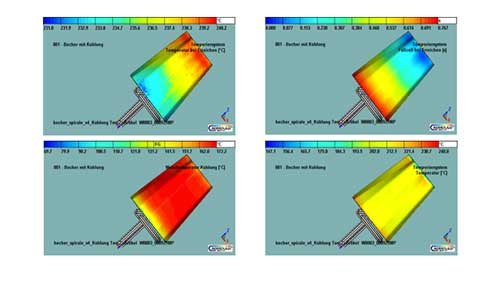
Design of conformales using the DMLS technology channels
The recommendations of design in the creation of channels for heating / cooling with DMLS are basically the same as those given to the conventional channels: both are conformales of control of the temperature of the mold based on the recrystallization of plastic and theories of thermal conductivity [2], with the necessary adaptations to the channels on one side and the advantages of the DMLS on the other hand (for example, the possibility of changing the cross-section along the path of the canal). The objective is that of the creation of a system of control of temperature of the mold, which allows a constant and adapted control of temperature of the material, during the injection process, following the recommendations of the manufacturer of material injection), at each point of the surface of the mold. To achieve this result, the diameter of the channel has to be selected depending on the distance between the canal of heating / cooling and the cavity. If the design of the injected piece is correct, the piece can be recristalizar a uniform and efficient in the mold after the injection phase, which improves the quality (in the absence of internal residual stress involves an injected piece deformation with a greater life cycle-free) and reduced injection cycle.
Based on experience, the optimal diameter should be designed between 4-12 mm (depending on the design of the injected piece). These values are for reference to be used in ideal situations, since in practice the mold inserts are sometimes too thin to make it possible to follow this rule accurately (e.g., a pair of suppliers that are close together)(, thin-walled, etc.). In the case of complex geometric conditions may be necessary to design smaller diameters, for example, when we remove a hot spot. The DMLS technology can build channels below 1 mm, but should take into account that these very fine channels only can be used with fluid especially treated to avoid obstructions (filtering of the cooling liquid is essential). There is software for simulation (Figure 1) specific help to optimize the correct circuit conformal in such critical cases.
To achieve maximum efficiency in the service (and in order to predict the effect on the design of mold), it is recommended the use of appropriate software for simulation and analysis (based on the FEM volume control). According to the current level of knowledge, there is an analysis software which is capable of simulating systems of heating / cooling in three dimensions with different transverse section Forms. But taking into account the complexity of the requirements for control of the temperature of the mold, the results of simulations with the approximation of the channels to a form circular should be sufficient as a first approximation.
Conclusions
EOS DMLS technology opens new frontiers for the implementation of forms of cooling / heating very effective and also offers the designer new possibilities for the production of high-performance molds - without considering the many constraints that characterize the conventional process. The additional challenge for the integration of such a system lies in that can be identified in the initial steps of the project, i.e. find the correct design of the conformales channels. The process of manufacture of the mould inserts is not influenced by the complexity of the chosen system of cooling as the DMLS technology simply builds the channels at the same time, without having a negative impact on the time of manufacture. In the light of all the benefits that such a system offers, considering the fact that most of the costs in the production of long series occur on a large scale in stage of cooling of the piece, has no justification to work without channels conformales production by means of injection moulds.
References
[1] Mike Shellabear, Joseph Weilhammer: Tooling Applications with EOSINT m.
In: EOS Whitepaper, July, September 2007.
[2] Olaf Zöllner, Optimised mould temperature control.
In: ATI 1104 d (Information Technology Application),
31.01.1999 Plastics Business Group, Bayer AG, Leverkusen, Germany.
[3] EOS website "Video of tooling application": http://www.eos.info/en/applications/tooling.html


